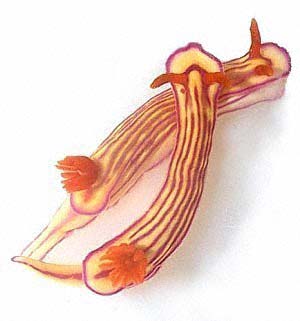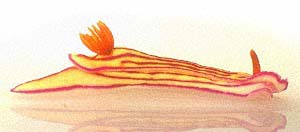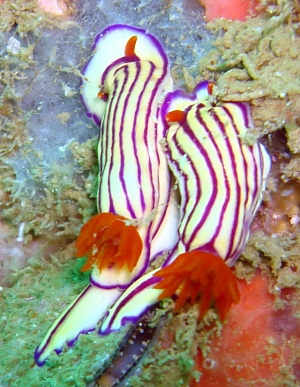

Hypselodoris maridadilus
Rudman, 1977
Order: NUDIBRANCHIA
Suborder: DORIDINA
Family: Chromodorididae
DISTRIBUTION
Western Indian Ocean
PHOTO
Bongoyo Is, off Kunduchi Bch, Dar es Salaam, Tanzania, February 1974, 30mm long. PHOTO: Bill Rudman.
RELATED TOPIC
At presently known only from the western Indian Ocean, including records from South Africa, Mauritius, Tanzania, Kenya, Reunion Is., Red Sea and the Arabian Sea. Records from the western Pacific are most probably Hypselodoris whitei. The animal of Hypselodoris maridadilus is yellow, with a purple border to the foot and the mantle, and a series of five longitudinal purple lines. the gills and rhinophores are bright orange-red. The body is relatively high and the front of the mantle widens to give the body a spatulate appearance. Indistinct violet transverse bands link the longitudinal lines. There are consistent colour differences between this species and Hypselodoris whitei. In that species the rhinophores have a white tip and the gills have a white inner edge. See my March 1, 1999 reply to Clay Bryce for a discussion on H. centunculus Yonow, 1994 which has been superceded by Gosliner & Johnson (1999) who examined the anatomy of one of Yonow's specimens and concluded that it is identical to Hypselodoris whitei in features of the radula and mantle glands.
References:
• Gosliner, T.M. & Johnson, R.F. (1999) Phylogeny of Hypselodoris (Nudibranchia: Chromodorididae) with a review of the monophyletic clade of Indo-Pacific species, including descriptions of twelve new species. Zoological Journal of the Linnean Society, 125: 1-114.
• Rudman, W.B. (1977) Chromodorid opisthobranch Mollusca from East Africa and the tropical West Pacific. Zoological Journal of the Linnean Society, 61: 351-397.
•Yonow, N. (1994) Opisthobranchs from the Maldive Islands, including descriptions of seven new species (Mollusca: Gastropoda). Revue fr. Aquariol., 20(4): 97-130.
Rudman, W.B., 1999 (March 1) Hypselodoris maridadilus Rudman, 1977. [In] Sea Slug Forum. Australian Museum, Sydney. Available from http://www.seaslugforum.net/find/hypsmard
Related messages
Hypselodoris maridadilus in Gulf of Oman, UAE
July 23, 2008
From: Yahia Mokhtar

Concerning message #18676:
Just about the statement "At presently known only from the western Indian Ocean from Tanzania, Kenya, Red Sea and Mauritius", the attached photos were taken in Fujairah, UAE in the Arabian Gulf/Indian Ocean.
The two animals are feeding on a blue sponge.
Locality: Shark-Island, Khurr-Fakkan, 12m, Fujairah, United Arab Emirates, Arabian Gulf/Indian Ocean, 11 January 2008, Rocks. Length: 25mm. Photographer: Yahia Mokhtar.
Yahia
yahia@adma.ae


Dear Yahia,
Thanks for the record. I will change my comments on its distribution on the Fact Sheet. While it's a great pleasure to be able to continually add new information to the Forum, it's combined with the pain of continaully having to update the Fact Sheets. Sometimes I am diligent but other times I am diverted by the need to post new messages. I hope most regular visitors realise, the Forum is continually growing, so the best way to find the latest on a species is to read through the recent messages attached to each Fact Sheet. Not all the information we have on a species is necessarily summarised in the Fact Sheet
Thanks also for the feeding record. We only have one other record of this species feeding on the Forum - and that was a guess by me from quite a blurry photo. Your photo confirms that it feeds on a dysideid sponge, which is what most species of Hypselodoris do. But we only know what they 'usually do' because of the help of observers like you.
Best wishes,
Bill Rudman
Spawn of Hypselodoris maridadilus: Reunion Island
December 1, 2006
From: Philibert Bidgrain


Concerning message #16222:
Spawn of Hypselodoris maridadilus: Reunion Island
Recently we found in our island some specimens of Hypselodoris maridadilus which present a different colour pattern. A little like Valda Fraser's specimen from South Africa. In the second photo we can observe a yellow spawn below the left animal. Do you think that it could be its spawn?
Locality: Saint Gilles, 20 m, Reunion Island, Indian Ocean, November 2006. Photographer: Philippe Cao Van and Sophie Darnis.
Philibert Bidgrain
http://vieoceane.free.fr/runseaslug/indexslug.htm
pbidgrain@yahoo.fr
Bidgrain, P., 2006 (Dec 1) Spawn of Hypselodoris maridadilus: Reunion Island. [Message in] Sea Slug Forum. Australian Museum, Sydney. Available from http://www.seaslugforum.net/find/18676
Dear Philibert,
The way the animal is curled around the top of the egg ribbon certainly suggests it is laying the egg ribbon. However part of the egg ribbon appears to be buried in the sand which would suggest it was laid some time before this photo was taken. I guess we will have to wait until we see another animal egg laying before we can 100% sure.
Best wishes,
Bill Rudman
Hypselodoris maridadilus from Sth Africa
April 1, 2006
From: David Holloway


Is this Hypselodoris centunculus? There does seem to be a hint of white on the middle of the gills of the right hand one which could make it H maridadilus.
Locality: Sodwana Bay, Stringer reef, 12 metres, Kwazulu Natal, South Africa, Indian, 30 December 2005, Exposed flat reef. Length: 20 - 30 mm. Photographer: David Holloway.
David Holloway.
davidh@idc.co.za
Holloway B.D., 2006 (Apr 1) Hypselodoris maridadilus from Sth Africa. [Message in] Sea Slug Forum. Australian Museum, Sydney. Available from http://www.seaslugforum.net/find/16222
Dear David,
Have a look at the messages concerning H. maridadilus and H. whitei. Firstly, Gosliner & Johnson (1999) consider H. centunculus to be a synonym of H. whitei, and you will see from my earlier comments that I am beginning to think H. whitei and H. maradadilus are one species. I would call yours H. maridadilus at present.
When I see more than one animal together like this my first thought is food and sure enough the sand-like mass they have their heads into is a sponge, almost certainly a species of Dysidea.
Best wishes,
Bill Rudman
Hypselodoris maridadilus from the Red Sea
February 17, 2004
From: Ilan Ben Tov

I saw this on January 30th 2004 in Eilat, Red Sea at depth of 4 meters. It was about 15mm long. Is it Gymnodoris striata ?
Ilan Ben Tov
ilanbt@yahoo.com
Ben Tov, I., 2004 (Feb 17) Hypselodoris maridadilus from the Red Sea. [Message in] Sea Slug Forum. Australian Museum, Sydney. Available from http://www.seaslugforum.net/find/12087Dear Ilan,
This is Hypselodoris maridadilus.
Best wishes
Bill Rudman
Hypselodoris maridadilus from South Africa
May 12, 2001
From: Valda Fraser


Dear Bill
Could you identify this animals please? The upper photo taken by Dennis King shows the rhinophores clearly. I would say that they are not tipped with white and the animal is therefore Hypselodoris centunculus. Would you agree?
Both photos are from Sodwana, north coast KwaZulu-Natal, SOUTH AFRICA.
UPPER: 15m depth, July 2000, 40mm long.
Photo: Dennis King
LOWER: 18m depth, Nov 2000, 35mm long.
Regards
Valda Fraser
valdafraser@mweb.co.za
Fraser, V., 2001 (May 12) Hypselodoris maridadilus from South Africa. [Message in] Sea Slug Forum. Australian Museum, Sydney. Available from http://www.seaslugforum.net/find/4307Dear Valda,
In my opinion both these animals are Hypselodoris maridadilus which I described from Tanzania. The main external difference between it and the western Pacific species Hypselodoris whitei is that the gills and rhinophores are a uniform translucent orange or orange-red in H. maridadilus while in H. whitei they are both tipped with white. Yonow (1994) described a species from the Maldives, H. centunculus, which differs in having a whitish tip to the rhinophores but not the gills. Erwin Koehler's photo from the Maldives, which I have tentatively identified as H. maridadilus is identical in colour to the photo published by Yonow of H. centunculus.
At this stage I cannot say whether H. centunculus is a distinct species. If you look carefully at the rhinophores of H. maridadilus the tip sometimes apears to be very pale, obviously because the skin pigment is much more transparent when there is no layer of tissue behind it. What I can't tell from the photos of H. centunculus is whether the white tips of the rhinophores are caused by a white pigment or whether some trick of the light is making the translucent tips appear pigmented white.
•Yonow, N. (1994) Opisthobranchs from the Maldive Islands, including descriptions of seven new species (Mollusca: Gastropoda). Revue fr. Aquariol., 20(4): 97-130.
Best wishes,
Bill Rudman.
Hypselodoris maridadilus from Mauritius
June 25, 1999
From: Erwin Koehler

Bill,
This photo is from Mauritius, taken by Georg Heinze. Size about 3 cm, about 20 m depth, Aug. 1993. Debelius has a similar looking one from Mauritius at top of page 239 IDed as H. mouaci. Is this slug the same one?
Erwin
Medslugs.Koehler@t-online.de
Koehler, E., 1999 (Jun 25) Hypselodoris maridadilus from Mauritius. [Message in] Sea Slug Forum. Australian Museum, Sydney. Available from http://www.seaslugforum.net/find/979Dear Erwin,
Yes this is the same as Debelius's photo. For some reason he says in his book that it stopped being called H. maridadilus in 1994. I have no idea who gave him that idea. The book well illustrates how vital it is to include references in works such as this. Be that as it may, I consider it to be a distinct species which I named from Tanzania some years ago.
Best wishes,
Bill Rudman.
Re: Hypselodoris maridadilus and H. whitei
March 3, 1999
From: Michael Miller


Dear Bill
Your posting of Hypselodoris maridadilus & H. mouaci etc. was most illuminating! Attached you will find two (2) pics of what I believe to be
Hypselodoris maridadilus based on that posting. Both animals were photographed at Tulamben, Bali, Indonesia in October '98. If so, it would seem to represent a significant range extension for this species. Apologize in advance for the quality of both photographs. If I had known what I was dealing with at the time, greater pains would have been taken at the photography end!
Cheers;
Michael Miller
mdmiller@cts.com
Miller, M.D., 1999 (Mar 3) Re: Hypselodoris maridadilus and H. whitei. [Message in] Sea Slug Forum. Australian Museum, Sydney. Available from http://www.seaslugforum.net/find/628Dear Mike,
Your description of my comments being "illuminating" reminds me of an old joke about how some people use statistics: "much like a drunk uses a lamp post - more for support than illumination!"
In fact your photos don't give much support to my suggestion. One of your photos (TOP RIGHT) certainly looks like H.maridadilus, with no white on the gills and rhinophores, but its a bit hard to ignore the white-tipped rhinophores in the other photo (LOWER RIGHT), which would fit Nathalie Yonow's H. centunculus. All I can say at this stage is I think we need some more photos.
Thanks for starting the ball rolling,
Bill Rudman.
Hypselodoris maridadilus & H. mouaci etc.
March 1, 1999
From: Clay Bryce
Bill,
You made the mistake of mentioning, when you posted the page on Hypselodoris emma that you would post some info on H. mouaci, Hypselodoris maridadilus and Hypselodoris whitei in the near future. Any chance this email will hurry you along a bit - not that I'm pressuring you but would be really interested to read what you think of H.mouaci vs H. maridadilus.
Cheers,
Clay.
Clay Bryce
Department of Aquatic Zoology (Molluscs)
Museum of Natural Science
Francis St.
Perth, 6000
W. Australia
brycec@museum.wa.gov.au
Bryce, C., 1999 (Mar 1) Hypselodoris maridadilus & H. mouaci etc.. [Message in] Sea Slug Forum. Australian Museum, Sydney. Available from http://www.seaslugforum.net/find/624Dear Clay,
Your plaintive email jogged me into action.. although I wouldn't say that this will be the final word.
It looks to me that there are a pair of sibling species, one in the Indian Ocean (H. maridadilus) and one in the western Pacific (H. whitei). The major difference would seem to be the white upper (inner)edge to each gill and the white tip to the rhinophore in the western Pacific species. There is some colour variation in the western Pacific with specimens from the northern end of the range, Japan, Hawaii, Enewetak having a very opaque whitish background colour which is replaced further south by a series of opaque white or cream patches on a darker translucent background. I can't find distinctive differences in radular morphology.
Nathalie Yonow described a species, Hypselodoris centunculus from the Maldives in the eastern Indian Ocean. She describes white-tipped rhinophores, which are characteristic of H. whitei, but she describes the gills as orange, which is characteristic of H. marididalus. It is difficult from the accompanying photo to see whether there is a white edging to the upper (inner) edge of the gills, or whether the white tips to the rhinophores are a photographic artifact. At this stage I think we will need to wait for more material, or at least photos, to determine the colour variability across the eastern Indian Ocean. I have posted two pages, Hypselodoris maridadilus and Hypselodoris whitei, one for each geographic region. Any further photos gratefully received.
Bill Rudman.
Rudman, W.B., 1999 (Mar 1). Comment on Hypselodoris maridadilus & H. mouaci etc. by Clay Bryce. [Message in] Sea Slug Forum. Australian Museum, Sydney. Available from http://www.seaslugforum.net/find/624